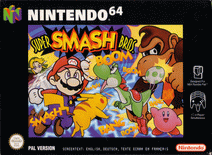
































Super Smash Bros.

Super Smash Bros. is a fighting video game developed by HAL Laboratory and published by Nintendo for the Nintendo 64 home video game console. It was released in Japan on January 21, 1999; in North America on April 26, 1999; and in Europe on November 19, 1999. Super Smash Bros. is the first game in the Super Smash Bros. series; its successor, Super Smash Bros. Melee, was released for the GameCube in 2001. It was given an Editors' Choice award from IGN for the “Best Fighting Game”. Super Smash Bros. was commercially successful, and became a Nintendo 64 Player's Choice title.
The game is a crossover between many different Nintendo franchises, including Mario, The Legend of Zelda, Star Fox, Donkey Kong, Metroid, Mother, F-Zero, Yoshi, Kirby, and Pokémon. It presents a cast of characters and locations from these franchises and allows players to use each character's unique skill sets and even take advantage of the stage's offensive events to inflict damage, recover health, and ultimately attempt to knock opponent characters off the stage. It received mostly positive reviews from the media and was commercially successful, selling over 5 million copies worldwide by 2001, with 2.93 million sold in the United States and 1.97 million copies sold in Japan. As a result of this success, the game spawned a series of sequels for each successive Nintendo console.
The Super Smash Bros. series is a departure from many fighting games; instead of winning by depleting an opponent's life bar, Smash Bros. players seek to knock opposing characters off a stage. Each player has a damage total, represented by a percentage, which rises as damage is taken and can exceed 100%, with a maximum damage of 999%. As this percentage rises, the character can be knocked progressively farther by an opponent's attacks. To KO an opponent, the player must send that character flying off the edge of the stage, which is not an enclosed arena but rather an area with open boundaries, many suspended in an otherwise empty space. When knocked off the stage, a character may use jumping moves in an attempt to return; some characters have longer-ranged jumps and may have an easier time 'recovering' than others. Additionally, characters have different weights, making it harder for heavier opponents to be knocked off the edge, but reciprocally harder for them to recover once sent flying.
While games such as Street Fighter and Tekken require players to memorize relatively lengthy and complicated button-input combinations often specific to only a particular character, Super Smash Bros. uses the same control combinations to access all moves for all characters. Characters are additionally not limited to only facing opponents, instead being allowed to run around freely on the stage. The game focuses more on aerial and platforming skills than other fighting games, with relatively larger, more-dynamic stages rather than a simple flat platform. Smash Bros. also implements blocking and dodging mechanics. Grabbing and throwing other characters is also possible.
Various weapons and power-ups can be used in battle to inflict damage, recover health, or dispense additional items. They fall randomly onto the stage in the form of items from Nintendo franchises, such as Koopa shells, hammers, and Poké Balls. The nine multiplayer stages are locations taken from or in the style of Nintendo franchises, such as Planet Zebes from Metroid and Sector Z from Star Fox. Although stages are rendered in three dimensions, players can only move within a two-dimensional plane. Stages are dynamic, ranging from simple moving platforms to dramatic alterations of the entire stage. Each stage offers unique gameplay and strategic motives, making the chosen stage an additional factor in the fight.
In the game's single-player mode, the player chooses a character with which to battle a series of computer-controlled opponents in a specific order, attempting to defeat them with a limited number of lives in a limited amount of time per challenger. While the player can determine the difficulty level and number of lives, the same series of opponents are always fought. If the player loses all of their lives or runs out of time, they have the option to continue at the cost of a considerable sum of their overall points. This mode is referred to as Classic Mode in sequels. The single-player mode also includes two minigames, 'Break the Targets' and 'Board the Platforms', in which the objective is to break each target or board multiple special platforms, respectively. The goal must be achieved without falling off each character-specific stage. A 'Training Mode' is also available in which players can manipulate the environment and experiment against computer opponents without the restrictions of a standard match.
Up to four people can play in multiplayer mode, which has specific rules predetermined by the players. Stock and timed matches are two of the multiplayer modes of play. This gives each player a certain number of lives or a selected time limit, before beginning the match. Free for all or team battles are also a choice during matches using stock or time. A winner is declared once time runs out, or if all players except one or a team has lost all of their lives. A multiplayer game may also end in a tie if two or more players have the same score when time expires, which causes the round to end in sudden death.
How to play:
Click on the joystick icon in the Super Smash Bros. online emulator to see how to control the Super Smash Bros. game









































Comments